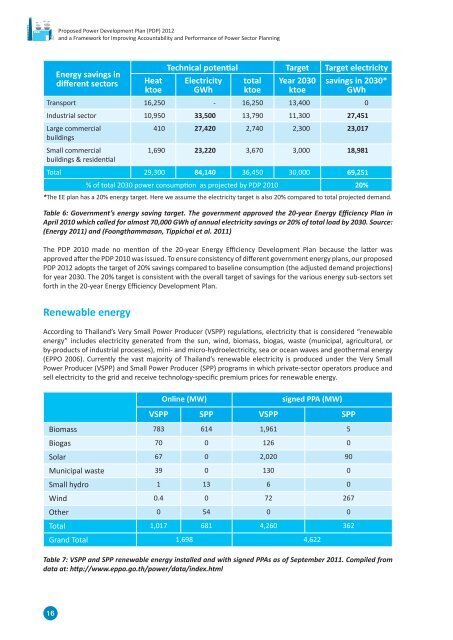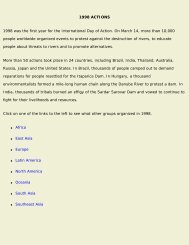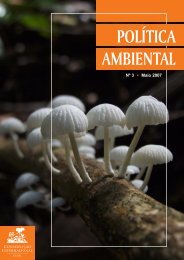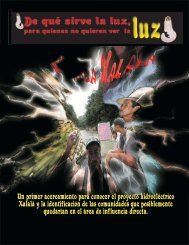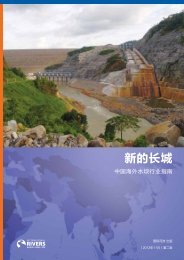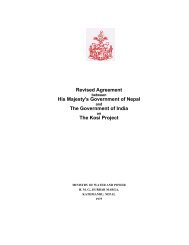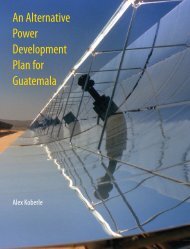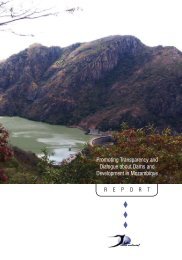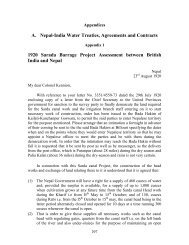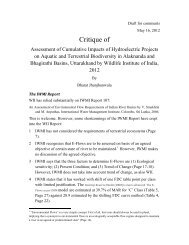Proposed Power Development Plan (PDP) 2012 - Palang Thai
Proposed Power Development Plan (PDP) 2012 - Palang Thai
Proposed Power Development Plan (PDP) 2012 - Palang Thai
- No tags were found...
You also want an ePaper? Increase the reach of your titles
YUMPU automatically turns print PDFs into web optimized ePapers that Google loves.
<strong>Proposed</strong> <strong>Power</strong> <strong>Development</strong> <strong>Plan</strong> (<strong>PDP</strong>) <strong>2012</strong>and a Framework for Improving Accountability and Performance of <strong>Power</strong> Sector <strong>Plan</strong>ningEnergy savings indifferent sectorsHeatktoeTechnical potential Target Target electricityElectricityGWhtotalktoeYear 2030ktoesavings in 2030*GWhTransport 16,250 - 16,250 13,400 0Industrial sector 10,950 33,500 13,790 11,300 27,451Large commercialbuildingsSmall commercialbuildings & residential410 27,420 2,740 2,300 23,0171,690 23,220 3,670 3,000 18,981Total 29,300 84,140 36,450 30,000 69,251% of total 2030 power consumption as projected by <strong>PDP</strong> 2010 20%*The EE plan has a 20% energy target. Here we assume the electricity target is also 20% compared to total projected demand.Table 6: Governmen t’s energy saving target. The government approved the 20-year Energy Efficiency <strong>Plan</strong> inApril 2010 which called for almost 70,000 GWh of annual electricity savings or 20% of total load by 2030. Source:(Energy 2011) and (Foongthammasan, T ippichai et al. 2011)The <strong>PDP</strong> 2010 made no mention of the 20-year Energy Efficiency <strong>Development</strong> <strong>Plan</strong> because the latter wasapproved after the <strong>PDP</strong> 2010 was issued. To ensure consistency of different government energy plans, our proposed<strong>PDP</strong> <strong>2012</strong> adopts the target of 20% savings compared to baseline consumption (the adjusted demand projections)for year 2030. The 20% target is consistent with the overall target of savings for the various energy sub-sectors setforth in the 20-year Energy Efficiency <strong>Development</strong> <strong>Plan</strong>.Renewable energyAccording to <strong>Thai</strong>land’s Very Small <strong>Power</strong> Producer (VSPP) regulations, electricity that is considered “renewableenergy” includes electricity generated from the sun, wind, biomass, biogas, waste (municipal, agricultural, orby-products of industrial processes), mini- and micro-hydroelectricity, sea or ocean waves and geothermal energy(EPPO 2006). Currently the vast majority of <strong>Thai</strong>land’s renewable electricity is produced under the Very Small<strong>Power</strong> Producer (VSPP) and Small <strong>Power</strong> Producer (SPP) programs in which private-sector operators produce andsell electricity to the grid and receive technology-specific premium prices for renewable energy.Online (MW)signed PPA (MW)VSPP SPP VSPP SPPBiomass 783 614 1,961 5Biogas 70 0 126 0Solar 67 0 2,020 90Municipal waste 39 0 130 0Small hydro 1 13 6 0Wind 0.4 0 72 267Other 0 54 0 0Total 1,017 681 4,260 362Grand Total 1,698 4,622Table 7: VSPP and SPP renewable energy installed and with signed PPAs as of September 2011. Compiled fromdata at: http://www.eppo.go.th/power/data/index.html16


